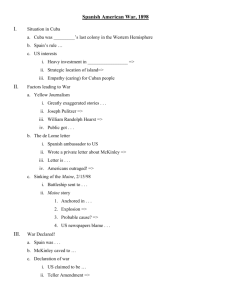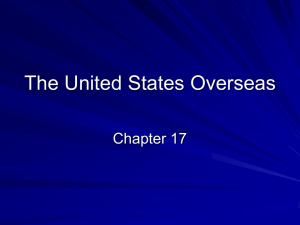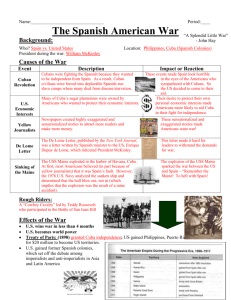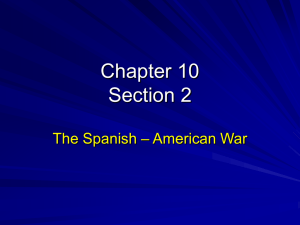The Spanish-American War
advertisement
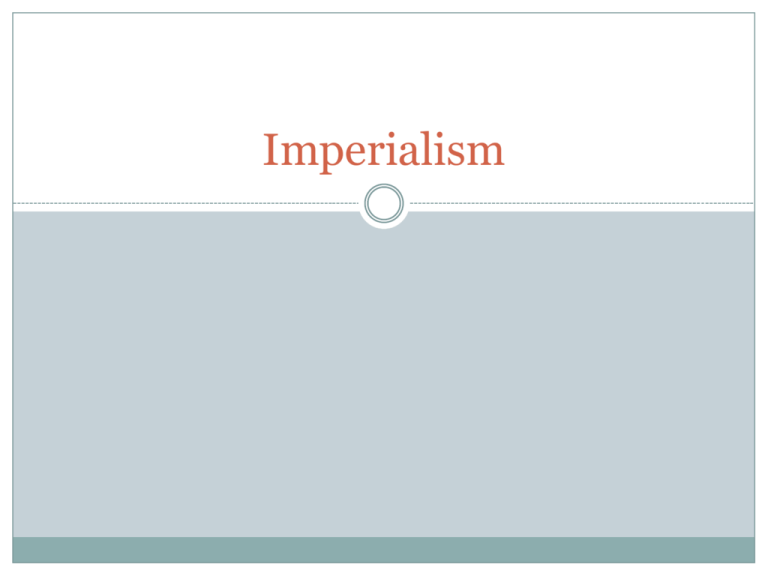
Imperialism Reasons for It Imperialism -> the policy in which stronger nations extend their economic, political, or military control over weaker territories 4 Reasons for Imperialism Global Competition Africa primarily controlled by Europe Japan + Europe compete for China Desire for Military Strength America must match other militaries Construct 9 cruiser ships (including Maine and Oregon) making U.S. 3rd largest naval force in the world Thirst for new markets Cultural Superiority Rebellion of the Cubans U.S. held large interest in Cuba (only 90 miles South of Florida) Wanted to buy from Spain Spain wasn’t having it Cubans rebel against Spain (U.S. sides with Cuban people) Revolt = unsuccessful but abolition of slaves happened The Spanish-American War 2nd War for Independence Anti-Spanish revolts again in Cuba Joes Marti -> launched revolution in 1895 deliberately destroying property, especially American-owned sugar mills and plantations Why? Intervention? War Fever Spain responds to revolt by sending General Valeriano Weyler to restore order Wanted to concentrate population in concentration camps Civilians could not aid rebels Yellow Journalism System of writing that exaggerates the news to lure and enrage readers Revolt produced stories such as poisoned wells and children being thrown to the sharks off the coast The De Lome Letter William McKinley took office in 1897 American intervention in Cuba favored Tried to do so through diplomatic means New York Journal published private letter Cuban rebel had stolen it from a Havana post Written by Spanish Prime Minister Enrique Dupuy de Lome Letter called McKinley “weak” American’s become angry about insult U.S.S. Maine President McKinley ordered the U.S.S. Maine to Cuba to bring home American citizens in danger from the fighting Feb. 15, 1898 the ship blew up in Havana harbor (260+ men killed) Newspapers claimed that the Spanish blew up the ship Headline read “The warship Maine was split in two by an enemy’s secret infernal machine” Offered reward of $50,000 for capture of Spaniards who did this War With Spain “Remember the Maine” U.S. declares war on Spain Philippines First battle took place here Opened fire on Spanish fleet at Manila (easy win) Joined forces with Philippines who also wanted freedom from Spain (force Spanish troops to surrender) Caribbean Started with blockade of Cuba (sealed Spanish in harbor) Inexperienced, poorly equipped soldiers Rough Riders Forces land in Cuba Included the Rough Riders (Leonard Wood/Teddy Roosevelt) Most famous battle takes place in Santiago Charge up Kettle Hill by Rough Riders and 2 African American regiments cleared way for an infantry attack on San Juan Hill Spanish try to escape blockade but are destroyed U.S. then invades Puerto Rico Treaty of Paris U.S. and Spain sign armistice after 15 weeks of fighting Conditions of the treaty: Spain freed Cuba Turned over islands of Guam and Puerto Rico Sold Philippines to the U.S. for $20mil. Debate over treaty U.S. have right to annex the Philippines? (Imperialistic views) Treaty violated the Declaration of Independence? (self gov’t) Settle race issues at home before social problems elsewhere Competition for American jobs Senate approved treaty and U.S. now had Guam, Puerto Rico, and the Philippines Acquiring New Lands Puerto Rico Became part of U.S. after Spanish-American War Puerto Ricans afraid they would not get independence fully Debate over independence or statehood… While there, Americans provided protection Ruled by military until gov’t decided otherwise Strategically important to the U.S. Foraker Act (set up civil gov’t) U.S. appointed governor and upper house of legislation Puerto Ricans elect legislator’s lower hosue Cuba + U.S. U.S. recognized Cuba’s independence and stated they had no intention of taking it over Cuba occupied by U.S. troops when war was over Feared U.S. replacing the Spanish rule Allowed Spanish officials to stay in office but also helped eliminate disease Platt Amendment Cuban gov’t wrote a constitution Did not specify relationship with U.S. U.S. insists they add provisions known as Platt Amendment Could not make treaties or allow any county to control it U.S. reserve right to intervene in Cuba Cuba was not to go into debt U.S. could buy/lease land in Cuba for Naval purposes Filipinos Rebel + China Not happy with Treaty of Paris (annexation) Thought they were promised independence (Emilio Aguinaldo) Began a revolt against U.S. Took 3 years to put down the revolt (set up similar gov’t like Puerto Rico) Fearful of U.S. being shut out of China the Open Door notes were created (established shared trade with imperialist powers) Boxer Rebellion Rid china of “foreign devils” Protecting American Interests 2nd Open Door notes “safeguard for the world the principle of equal and impartial trade with all parts of the Chinese Empire” Revealed American beliefs Growth of economy depended on exports Had a right to intervene abroad to keep foreign markets open Feared that the closing of an area to U.S. threatened survival
